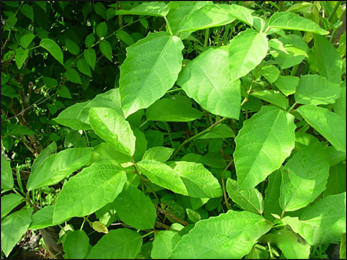Danti, Red Physic Nut (Baliospermum montanum)

Description of plant
Danti (Baliospermum montanum) is monoecious and stout undershrub that grows up to 1.8mt in height. This plant has herbaceous branches that are arising from the roots. The upper branches of Berberis aristata bear small, lanceolate leaves, while the lower branches have larger, simple, 3–5 lobed leaves with sinuate-toothed margins. The plant produces unisexual flowers, which are numerous and arranged in axillary racemes.
Male flowers have a round, membranous calyx, finely mottled, and contain 5–6 disc glands. Female flowers are small, hairy, with ovate to lanceolate sepals. The fruits are three-lobed capsules, and the seeds are smooth, mottled, and contain an oily endosperm.
Flowering occurs in January and February, with fruiting typically one month later.
General information
Danti is a shade loving plant that grows in a well humid climate. Red physic nut, wild castor, wild croton and wild sultan seeds are various common names of this herb. It is a medicinal herb used in ayurvedic medicine for various diseases. For various medicinal purposes, leaves, dantimool or dried root is used. Seeds and roots of this plant are purgatives. The solvents and extracts of the root of Berberis aristata exhibit anticancer, antioxidant, antimicrobial, immunostimulatory, and hepatoprotective properties. The plant contains a variety of bioactive compounds, including glycoterpenoids, steroids, flavonoids, triterpenoids, diterpenes, and saponins. The leaves possess anti-asthmatic properties and are also known for their wound-healing effects
Special note about Danti (Danti shodhana)
According to Charaka for the purification of dantimool danti roots are coated in paste of pippali and madhuka. After that this mass is wrapped in grass, tied and wrapped under the mud covering. This wrapped mass is heated to reduce the toxicity of dantimool.
Habitat
Danti is widely distributed throughout the sub Himalayan tracts from khasi hills to Kashmir. It is easily available in Bengal, Bihar, Madhya Pradesh and peninsular India.
Classification
- Kingdom – Plantae
- Order – Malpighiales
- Family – Euphorbiaceae
Names
- Latin name – Baliospermum montanum
- English name – Red physic nut, Wild castor, Wild croton
- Hindi name – Danti, Hakum, Hakun
- Bengali name – Danti, Hakun
- Gujarati name – Dantimul, Jamalgota
- Marathi name – Danti
- Telugu name – Ettadungida, Kanakapata
- Tamil name – Kattamaraku, Niradimutta
- Malayalam name – Dantika, Katalavanakku, Nagadanti
- Oriya name – Donti
- Burma name – Natcho
- Persian name – Bedanjirekhatai
- Arabic name – Habbussalantinebarri
Ayurvedic Properties
| Hindi / Sanskrit | English | ||
| Rasa | Katu | Taste | Pungent |
| Guna | Guru, Tikshna | Physical Property | Heavy, Sharp |
| Virya | Ushna | Potency | Hot |
| Vipaka | Katu | Metabolic Property (After Digestion) |
Pungent |
Effects on dosha
It balances pitta and kapha dosha.
| Charak Samhita | Sushrut Samhita | Vagbhata |
|
Shamayadi, adhobhaghara | Shamayadi |
Raj nighantu
According to Rajnighantu, there are two types of danti:-
- Danti (Laghu Danti)
- Dravanti (Brehat Danti)
Ancient Verse about Danti


- According to the first shalok, Laghu danti and brhat danti are two types of danti. Laghudanti, vishalya, udumberparni, erandpahla, shighra, sheyanghanta, ghunpriya, barahangi, nikhumbh, and mukulak are various synonyms of laghu danti. Dravanti, shambri, chitra, pratyakparni, akhuparni, upchitra, shrutshroni, naygrodhi and vrisha are synonyms of brahat danti. Its leaves and branches resemble a castor. Both are pungent in taste, hot potency and have sharp properties and act as purgative and stimulant. Danti is used to cure hemorrhoids, calculi, abdominal pain, itching, leprosy, burning sensation, inflammation, abdominal disorders, bleeding disorders and worm infestation.
- According to the second shalok, Laghu danti is sweet in taste, has cold potency, good for both urination and purgation. It is used to pacify kapha dosha and used to treat poisoning and inflammation.
Practical Uses of Danti (Baliospermum montanum)
- Danti is a blood purifier and paste of danti roots and seeds are used to reduce edema and pain. Both act as analgesics to relieve pain.
- This herb has antipyretic properties and is used to treat fever. This herb is also anti-inflammatory and used to reduce inflammation. Decoction of danti is used in pittaj jawara.
- Roots are laxative and highly purgative in nature. Seeds and root powder of this herb is used to relieve constipation and it is best used for patients of piles.
- Danti leaves are found to be very beneficial for the sufferers of jaundice.
- Decoction of Leaves are used to treat asthma and bronchitis by pacifying kapha dosha. Paste of danti leaves are applied for quick healing of wounds.
- Externally seeds of danti are used as stimulant and rubefacient. This herb is very effective in abdominal pain, bloating and abdominal tumors.
- Roots of this herb are pungent, heating and diuretic in nature. It is also used in hemorrhoids, abdominal tumors and enlarged spleen.
- External use of root paste over pile mass causes reduction in pain, swelling and shrinkage of pile mass.
- Seed oil of danti is very effective in treating vata disorders like paralysis, sciatica, gout and neurological disorders etc.
- Seed paste is also applied in poisoning of snake bites.
- Danti is used to pacify pitta and kapha dosha.
Part Used
- Roots
- Leaves
- Seeds
- Seed oil
Dosage
- Root powder – 1-3gm
- Seed powder – 125-250mg
- Seed oil – 3-5 drops
Cautions
- It is not recommended in pregnancy and lactation.
- Overdose may cause severe pain, nausea, diarrhea and vomiting.
Planet Ayurveda Products that Use this Herb
Mahashankh Vati
- Balances Vata, Pitta and Kapha (Physical Energies) in body.
- Maintains healthy metabolism
- Maintains healthy digestion
- 100% natural product
- Absolutely free from chemicals, additives, extra colors, fillers and yeast etc.
- Formulated by M.D Ayurveda experts




